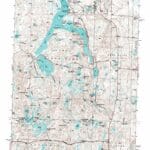Discovering Gruver: History, Community, and Panhandle Spirit
Gruver, Texas, nestled in the heart of Hansford County on State Highway 15 at an elevation of approximately 3,176 feet, is more than just a dot on the map. This small town, encompassing 1.1 square miles, holds a history as vast as the surrounding plains, a story of resilience forged in the face of adversity, and a community spirit that shines brightly. This article delves into the heart of Gruver, exploring its past, present, and the enduring legacy that shapes its future.
From Ranching Roots to the Rise of a Town
Imagine the Texas Panhandle in the early 1900s: a boundless expanse of prairie under a vast sky. Around 1907, amidst this landscape, Joseph Hezkiah Gruver and his son, Lawrence, established a ranch, laying the foundation for the town that bears their name. Their initial focus on cattle eventually shifted towards wheat cultivation, contributing to the Panhandle’s reputation as a vital agricultural region.
The arrival of the Chicago, Rock Island and Pacific Railroad in 1929 proved pivotal. This steel artery connected Gruver to the wider world, fostering trade and transforming the once quiet settlement into a bustling hub. Just a year later, in 1930, Gruver officially became a town. This growth, however, contrasts sharply with the fate of nearby Old Farwell. Founded in 1880 by the Canott family and serving as Hansford County’s original seat, Old Farwell predates Gruver. Historians suggest that the railroad’s route, which bypassed Old Farwell, likely contributed to its decline while simultaneously fueling Gruver’s growth. This illustrates how infrastructure can dramatically reshape the destinies of communities.
A Community Forged in Resilience: The 1971 Tornado
Gruver’s history is not just one of growth, but also of resilience. On June 9, 1971, a devastating tornado, the largest recorded at the time, ripped through the area. While later surpassed in size by tornadoes in Hallam, Nebraska (2004), and El Reno, Oklahoma (2013), the Gruver tornado remains a significant event, indelibly etched in the town’s memory. The destruction was widespread, but the spirit of Gruver remained unbroken. In the aftermath, stories of neighbors helping neighbors, of shared burdens and collective rebuilding, emerged, showcasing the true strength of the community.
Gruver Today: A Small Town with a Big Heart
Today, Gruver, with a population hovering around 1,130 (2020 Census), retains its small-town charm while embracing the future. Navigating through varying population figures from different sources—1,162 (2000 Census) and an estimated 1,574 (Census Reporter)—highlights the challenge of accurately capturing demographics in a dynamic community.
Exploring Gruver: A Visitor’s Guide
- Gruver Independent School District (GISD): The local school district, particularly Gruver High School, serves as a cornerstone of the community, fostering education and local pride.
- Local Businesses: From the Gruver Cafe (602 Main Ave, Gruver, TX; (806) 733-2334), a beloved local diner where stories are shared over plates of comfort food, to other unique businesses waiting to be discovered, Gruver offers a taste of small-town hospitality.
- City Government: The City of Gruver website (cityofgruver.com) provides a wealth of information about city services, departments, public notices, and more. It’s a digital town hall, connecting residents and visitors to the heart of local governance.
Beyond Gruver: Exploring the Region
Discover other hidden gems in the area, such as Gueydan, Louisiana, and delve into the comprehensive resources available through the Hillsborough County SOE.
The Future of Gruver: Growth and Preservation
While the 1971 tornado remains a poignant chapter in Gruver’s history, it also underscores the town’s remarkable resilience. Moving forward, Gruver faces the challenge of balancing growth and preservation—honoring its past while embracing the future. This involves addressing questions about economic development, community initiatives, and the ongoing evolution of small-town life in the 21st century. Further research into these areas will provide a more comprehensive understanding of the forces shaping Gruver’s future. By fostering a deeper understanding of its history and embracing the spirit of its community, Gruver is poised to continue its journey as a vibrant and enduring town in the Texas Panhandle.
- Unlock Elemental 2 Secrets: Actionable Insights Now - April 2, 2025
- Lot’s Wife’s Name: Unveiling the Mystery of Sodom’s Fall - April 2, 2025
- Photocell Sensors: A Complete Guide for Selection and Implementation - April 2, 2025
















